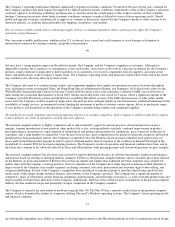Apple 2003 Annual Report Download - page 38
Download and view the complete annual report
Please find page 38 of the 2003 Apple annual report below. You can navigate through the pages in the report by either clicking on the pages listed below, or by using the keyword search tool below to find specific information within the annual report.
will favorably impact net sales either in the short or long term.
The Company faces increasing competition in the U.S. education market.
Sales in the United States to both elementary and secondary schools, as well as for college and university customers, remain a core market for
Apple. Net sales in these markets fell to 18% of the Company's total net sales in 2003 from 21% and 26% in 2002 and 2001, respectively. The
drop in 2003 reflects declines in both net sales and Macintosh unit sales in these markets of 4% and 6%, respectively, in fiscal 2003 compared
to 2002. Additionally, several competitors of the Company have either targeted or announced their intention to target the education market for
personal computers, which could also negatively affect the Company's market share. In an effort to regain market share and remain
competitive, the Company has been and will continue to pursue 1:1 learning solutions in education. These 1:1 solutions and other strategic
sales are generally priced more aggressively and could result in significantly less profitability or even in financial losses, particularly for larger
deals. Although the Company believes it has taken certain steps to strengthen its position in the education market, there can be no assurance
that the Company will be able to increase or maintain its share of the education market or execute profitably on large strategic arrangements.
Failure to do so may have an adverse impact on the Company's operating results and financial condition.
The Company's future operating performance is dependent on the performance of distributors and other resellers of the Company's products.
The Company distributes its products through wholesalers, resellers, national and regional retailers and cataloguers, many of whom distribute
products from competing manufacturers. In addition, the Company also sells many of its products and resells certain third-party products in
most of its major markets directly to end users, certain education customers, and certain resellers through its online stores around the world.
The Company also sells its own products and certain third-party products through its retail stores. Many of the Company's significant resellers
operate on narrow product margins and have been negatively affected by current economic conditions. Considerable trade receivables that are
not covered by collateral or credit insurance are outstanding with the Company's distribution and retail channel partners. The Company's
business and financial results could be adversely affected if the financial condition of these resellers weaken, if resellers within consumer
channels were to cease distribution of the Company's products, or if uncertainty regarding demand for the Company's products caused resellers
to reduce their ordering and marketing of the Company's products. The Company has invested and will continue to invest in various programs
to enhance reseller sales, including staffing selected resellers' stores with Company employees. These programs could require a substantial
investment from the Company, while providing no assurance of return or incremental revenue to offset this investment.
Over the past several years, an increasing proportion of the Company's net sales have been made by the Company directly to end-users through
its online stores around the world and through its retail stores in the United States. Some of the Company's resellers have perceived this
expansion of the Company's direct sales as conflicting with their own business and economic interests as distributors and resellers of the
Company's products. Perception of such a conflict could discourage the Company's resellers from investing additional resources in the
distribution and sale of the Company's products or lead them to limit or cease distribution of the Company's products. The Company's business
and financial results could be adversely affected if expansion of its direct sales to end-users causes some or all of its resellers to cease or limit
distribution of the Company's products.
Further information regarding risks associated with Marketing and Distribution may be found in Part I, Item 1 of this Form 10-K under the
heading "Markets and Distribution," which information is hereby incorporated by reference.
46
The Company's business is subject to the risks of international operations.
A large portion of the Company's revenue is derived from its international operations. As a result, the Company's operating results and
financial condition could be significantly affected by risks associated with international activities, including economic and labor conditions,
political instability, tax laws (including U.S. taxes on foreign subsidiaries), and changes in the value of the U.S. dollar versus the local currency
in which the products are sold and goods and services are purchased. The Company's primary exposure to movements in foreign currency
exchange rates relate to non-dollar denominated sales in Europe, Japan, Australia, Canada, and certain parts of Asia and non-dollar
denominated operating expenses incurred throughout the world. Weaknesses in foreign currencies, particularly the Japanese Yen and the Euro,
can adversely impact consumer demand for the Company's products and the U.S. dollar value of the Company's foreign currency denominated
sales. Conversely, strengthening in these and other foreign currencies can increase the cost to the Company of product components, negatively
affecting the Company's results of operations.
Margins on sales of Apple products in foreign countries, and on sales of products that include components obtained from foreign suppliers, can
be adversely affected by foreign currency exchange rate fluctuations and by international trade regulations, including tariffs and antidumping
penalties.
Derivative instruments, such as foreign exchange forward and option positions, and interest rate swap and option positions have been utilized
by the Company to hedge exposures to fluctuations in interest rates and foreign currency exchange rates. The use of such hedging activities
may not offset more than a portion of the adverse financial impact resulting from unfavorable movements in either foreign exchange or interest
rates.
























